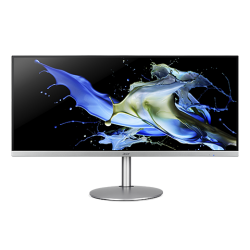I spent years working on a dual monitor setup and just recently purchased an ultrawide monitor to replace them in my home office. The monitor I bought is an 34” Acer CB342CK (3440x1440) with a 21:9 aspect ratio, and I only use it for “standard” office work (no video editing, photoshop, gaming, etc.) so some of the more expensive options weren’t necessary. I managed to buy it certified refurbished for $280, which seemed very reasonable given the cost of other similar options. The main factors that drew me to the ultrawide monitor were:

I’ve come to really like the monitor when working with large spreadsheets or when hunting through a dozen internet tabs. The extra “wide” space allows you to see a lot more than a standard 16:9 aspect ratio and makes everything easier to work with, which is something you can’t do with two separate monitors. Working with two windows side-by-side is OK, but I’m not sure if I prefer it over dual monitors yet. I find myself using the Windows Key + Left/Right shortcut a lot to split the windows to either side of the screen, which isn’t as quick or easy as clicking and dragging to maximize like you would with a true dual monitor setup. Plus, while the 21:9 aspect ratio provides plenty of space to work with two windows, you still lose space when compared to two separate 16:9 monitors.
If you spend most of your time in large spreadsheets or single, wide windows it may make sense to use an ultrawide monitor. The ultrawide also looks great and only requires a single display connection, which makes it attractive for those with a tablet-style laptop that only has a single port. If you’re willing to spend some serious money ($900+) on your setup, you can opt for something like the 49” Curved Samsung monitor with a 32:9 aspect ratio that gives you a true “dual monitor” feel on a single screen. Otherwise, a standard dual monitor setup provides the same productivity for cheaper with a slightly lower “cool factor”.

- It provides a large, seamless screen to work on big spreadsheets etc.;
- It can easily accommodate two open windows side-by-side for productivity; and
- It looks cool.
I’ve come to really like the monitor when working with large spreadsheets or when hunting through a dozen internet tabs. The extra “wide” space allows you to see a lot more than a standard 16:9 aspect ratio and makes everything easier to work with, which is something you can’t do with two separate monitors. Working with two windows side-by-side is OK, but I’m not sure if I prefer it over dual monitors yet. I find myself using the Windows Key + Left/Right shortcut a lot to split the windows to either side of the screen, which isn’t as quick or easy as clicking and dragging to maximize like you would with a true dual monitor setup. Plus, while the 21:9 aspect ratio provides plenty of space to work with two windows, you still lose space when compared to two separate 16:9 monitors.
If you spend most of your time in large spreadsheets or single, wide windows it may make sense to use an ultrawide monitor. The ultrawide also looks great and only requires a single display connection, which makes it attractive for those with a tablet-style laptop that only has a single port. If you’re willing to spend some serious money ($900+) on your setup, you can opt for something like the 49” Curved Samsung monitor with a 32:9 aspect ratio that gives you a true “dual monitor” feel on a single screen. Otherwise, a standard dual monitor setup provides the same productivity for cheaper with a slightly lower “cool factor”.

